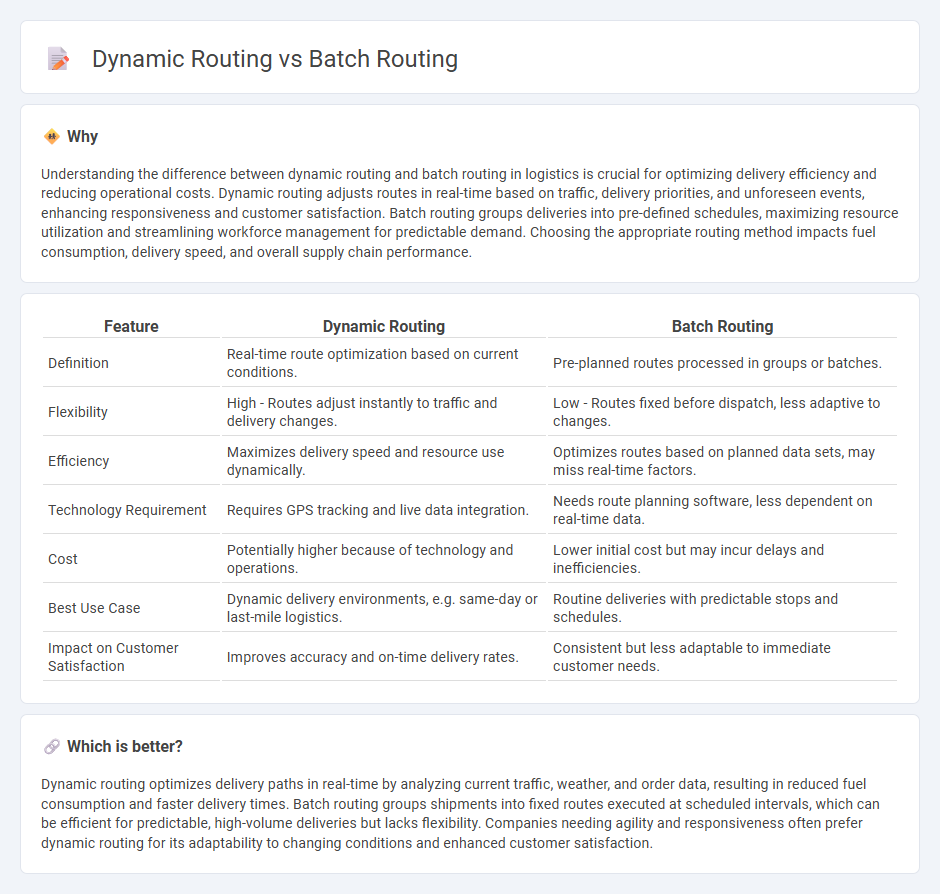
Dynamic routing optimizes delivery routes in real-time based on current traffic, order changes, and driver availability, enhancing efficiency and reducing fuel consumption. Batch routing, by contrast, groups shipments into fixed routes scheduled in advance, allowing for predictable planning but less flexibility. Explore the benefits and applications of both routing strategies to improve your logistics operations.
Why it is important
Understanding the difference between dynamic routing and batch routing in logistics is crucial for optimizing delivery efficiency and reducing operational costs. Dynamic routing adjusts routes in real-time based on traffic, delivery priorities, and unforeseen events, enhancing responsiveness and customer satisfaction. Batch routing groups deliveries into pre-defined schedules, maximizing resource utilization and streamlining workforce management for predictable demand. Choosing the appropriate routing method impacts fuel consumption, delivery speed, and overall supply chain performance.
Comparison Table
| Feature | Dynamic Routing | Batch Routing |
|---|---|---|
| Definition | Real-time route optimization based on current conditions. | Pre-planned routes processed in groups or batches. |
| Flexibility | High - Routes adjust instantly to traffic and delivery changes. | Low - Routes fixed before dispatch, less adaptive to changes. |
| Efficiency | Maximizes delivery speed and resource use dynamically. | Optimizes routes based on planned data sets, may miss real-time factors. |
| Technology Requirement | Requires GPS tracking and live data integration. | Needs route planning software, less dependent on real-time data. |
| Cost | Potentially higher because of technology and operations. | Lower initial cost but may incur delays and inefficiencies. |
| Best Use Case | Dynamic delivery environments, e.g. same-day or last-mile logistics. | Routine deliveries with predictable stops and schedules. |
| Impact on Customer Satisfaction | Improves accuracy and on-time delivery rates. | Consistent but less adaptable to immediate customer needs. |
Which is better?
Dynamic routing optimizes delivery paths in real-time by analyzing current traffic, weather, and order data, resulting in reduced fuel consumption and faster delivery times. Batch routing groups shipments into fixed routes executed at scheduled intervals, which can be efficient for predictable, high-volume deliveries but lacks flexibility. Companies needing agility and responsiveness often prefer dynamic routing for its adaptability to changing conditions and enhanced customer satisfaction.
Connection
Dynamic routing optimizes logistics by adjusting delivery routes in real-time based on current traffic and demand, enhancing efficiency and reducing costs. Batch routing groups multiple deliveries into a single route to maximize resource utilization and streamline operations. Combining dynamic routing with batch routing enables logistics providers to adapt grouped deliveries on the fly, improving overall supply chain responsiveness and customer satisfaction.
Key Terms
Fixed Schedules (Batch Routing)
Batch routing operates on fixed schedules, ensuring deliveries occur at predetermined times for consistent route planning and resource allocation. This method benefits businesses with predictable demand patterns, allowing cost-effective and streamlined logistics operations. Explore how fixed schedule batch routing can optimize your supply chain efficiency.
Real-Time Optimization (Dynamic Routing)
Dynamic routing leverages real-time data and algorithms to optimize delivery routes on the fly, reducing travel time, fuel consumption, and improving service efficiency. Batch routing, conversely, plans routes in advance without adapting to real-time changes, often resulting in less flexibility and responsiveness. Explore how real-time optimization transforms logistics by adapting to live conditions for maximum operational performance.
Flexibility (Dynamic Routing)
Dynamic routing offers superior flexibility by automatically adjusting paths based on real-time network conditions, optimizing traffic flow and reducing congestion. Unlike batch routing, which processes data in fixed intervals, dynamic routing adapts continuously to changes, improving responsiveness and network efficiency. Explore how dynamic routing enhances operational agility and network performance in various applications.
Source and External Links
Batch Routing service | Routing API - Batch Routing enables dispatching batches of route and reachable range calculations either synchronously (for up to 100 routes with quick response) or asynchronously, allowing multiple routing requests to be processed in bulk.
Batch Routing API - NexBillion.ai - NexBillion.ai's Batch Routing API supports submitting multiple routing requests (currently for isochrone queries) collectively via HTTP POST, with asynchronous retrieval of results using a tracking ID.
What is Batch Routing and Matrix Routing? - Batch routing allows developers to request multiple optimized routes at once for complex scenarios, enhancing routing applications by enabling faster and more efficient determination of paths between origins and destinations.
 dowidth.com
dowidth.com